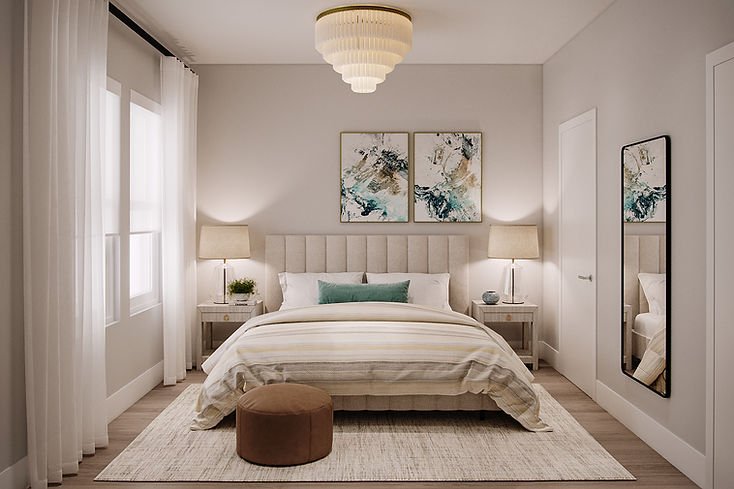Decorating a small space can be daunting, especially when you’re trying to maximize your available space. But, while it may seem like your amount of square footage is cramping your style, there are plenty of ways you can design a small space so that it’s both functional and stylish. To help you avoid learning about these design mishaps the hard way, we rounded up the best tips from design experts from Pasadena, CA, all the way to Ottawa, ON, on what not to do when decorating small spaces, plus how you can fix them.
1) Going with the wrong color palette
Wall painting has a significant impact on designing a small place. Going with light colors helps the space look spacious and roomy. –Key Interiors Design
2) Not having the correct sized rug
There’s nothing like buying the wrong-sized rug to shrink the size of a room. Bigger is better, and at the very least, the front legs of the furniture pieces should rest on the rug. Having all the furniture pieces on the rug will make your living room feel even more spacious. –Grunberger Interiors
3) Forgetting to draw the eye up to the “fifth wall” (a.k.a the ceiling)
Designing a unique ceiling – whether it’s by selecting a beautiful paint color or installing a patterned wallcovering – adds interest and personalization. This also creates a sense of height in the room by drawing the eye up. –Soul Interiors Design
4) Not having ample lighting
Opt for a combo of natural and artificial lighting to avoid making a small space feel dingy and cramped. You can also add window coverings to control the sunlight coming into the space. For artificial lighting, layering and dimmers are key. For example, use a ceiling fixture for ambient, table lamps for task lighting, and backlight a wall-mounted TV with an LED strip for accent lighting. –Ginet Casido Interiors
5) Using small furniture in a small space
One of the biggest mistakes is that most people believe that you need small furniture for a small space. This is not true. Instead, focus on scale and proportion. –Sol Interiors

6) Forgetting the importance of the entryway
New homeowners and sellers commonly forget about the entryway since it’s a smaller space. However, it’s the first part of the house that can set your home’s entire tone and feel. New homeowners are so excited to purchase furniture but forget about the importance of the functionality and the feel of the entryway. Ask yourself: What do I want to see immediately to feel like home? Where am I putting my purse or laptop bag? My jacket? My keys? Sellers need to immediately create the “I’m Home” sentiment when buyers walk in with those functional spaces and a little personal touch. –Jolie Home Interiors
7) Overstuffing the space with bulky furniture
Instead of cramming bulky furniture into every corner of your small space – remember that “less is more” and always commit to the design golden rule and measure, measure, measure. By sticking with these simple tips, finding furnishings that are the perfect scale for your room will be a breeze. Don’t forget to add some live plants (such as palm plants) to create height, beauty, good breathing air for the room, and they won’t take up a lot of room either. –Spatial Harmony
8) Underutilizing alternative storage options
I like to create storage wherever possible. So for a small space, I’d look to add floating cabinetry instead of a large console under a wall-mounted TV. It frees up floor space and gives the illusion of more room. Using a floor planning app (or pen and paper) to measure the space and play around with different configurations is also the easiest way to figure out the size of furniture required. –Cindy Krauklis Interiors
9) Using oversized or dark furniture
To help the look a small space appear larger, be selective of which furniture pieces you use. A decorating mistake I notice is people stuffing a room with oversized dark furniture. Choose smaller scale furniture, lighter color fabrics, and furniture pieces with exposed legs to make the space look open and airy. –Steward of Design
10) Going with style over substance
Functionality is key in a small space. Since there’s no room for purely decorative items, pieces that can look beautiful and help with storage, organization, or serve another purpose are the best of both worlds. No big fillers allowed. Pull-out storage (a.k.a, drawers and pullout shelves) maximizes the capacity of any cabinet. Add some bins or storage organizers, and the number of items that’ll fit into the space will exceed expectations. –Detail by Design
11) Overusing color
Monochromatic rooms assist in allowing your eyes to feel at ease in small spaces. Try using various tones of that hue by incorporating it into your art, window treatments, accessories, and or wall color for that space. –Flipping Design
12) Having too many decor pieces on display
Most people just put too many little tchotchkes on the shelf. Shelves look best when you have a few large pieces to anchor the space. Use a simple 1-2-3 rule to make sure shelves are impactful. A single piece on one shelf, then three pieces on the next, and two below. By keeping the shelves light, you can create a more impactful presentation. –Nalini + Co. Design
13) Underusing multi-purpose or versatile furniture pieces
Opt for folding pieces (versatile furniture) when decorating small spaces. Making a gap out of any small space is always a plus when you need to decorate your small living area. You may want to place a desk and a dining table, but do you need them 24-7? Consider installing such furnishings that can fold up when not in use. This way, you’ll be able to free up the maximum amount of floor space and make room for walkways. –Own It Interiors

